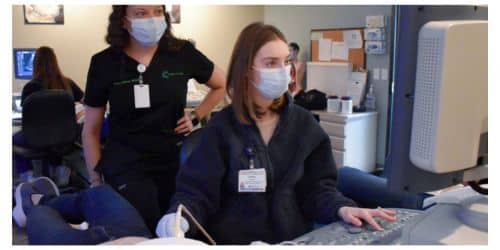Diagnostic medical sonography could be a good job for you if you like to help people and work in a fast-paced challenging workplace. Sonographers, ultrasound technologists, and ultrasound technicians are all different names for the same kind of highly trained allied health worker. Most people think of an ultrasound specialist as someone who does ultrasounds on pregnant women, but this isn’t the only job they can do. In this guide, you will learn the meaning of “ultrasound technician,” how to become one, their salary, requirements, and program.
Ultrasound Technician
Ultrasound technicians, also called sonographers, use ultrasound equipment to take medical pictures of the inside of the body. These photos aid physicians and specialists in the diagnosis, treatment, and monitoring of patients. Ultrasound technicians employ sound waves to provide diagnostic images of the inside of the organs without requiring any intrusive procedures. The technology, which doesn’t use radiation and is considered safe and low-risk, can take pictures of the vascular system, organs, tissues, joints, muscles, and babies. A radiologist interprets the images once the ultrasound technician has provided them with their observations and a report. The radiologist or doctor who ordered the pictures gives the results to the patient. Ultrasound can detect a variety of medical conditions, including:
- Abnormal growths on the thyroid or elsewhere.
- Blockages in arteries.
- Tumors, such as liver cancer.
Ultrasounds are also frequently used throughout pregnancy to monitor the developing baby and the patient’s reproductive system’s progress, as well as to determine whether the fetus is male or female.
How to Become Ultrasound Technician
The following includes how to become an ultrasound technician:
#1. Obtain Formal Educational
Most ultrasound technicians start out by going to school in an area that has something to do with health care. Health studies, biology, anatomy, or chemistry are some of the choices. Diagnostic medical imaging is the name of a study that some schools offer that puts more emphasis on sonography. You can get an associate’s degree or a bachelor’s degree in one of these areas.
#2. Consider a Specialty
You can select from a variety of expertise in the medical industry as an ultrasound technician. In addition to prenatal health, ultrasound technicians can specialize in:
- Vascular or cardiac: They focus on ultrasounds of the heart and blood vessels.
- Abdominal: They evaluate the organs of the abdomen, including the kidneys, liver, and bladder.
- Nero: This is a part of sonography that studies the brain and how it works.
- Breast: This type of sonography looks for signs of breast cancer in the breast area.
- Obstetric or gynecologic sonography: This type of sonography evaluates a female’s reproductive organs as well as a fetus in the womb’s prenatal health.
Multiple areas of expertise are available to ultrasound technicians. Once you’ve decided which specialty you’re most interested in, you can focus on getting the suggested certifications.
#3. Complete Certification
The American Registry for Diagnostic Medical Sonography (ARDMS), Cardiovascular Credentialing International (CCI), and the American Registry of Radiologic Technologists (ARRT) are the three organizations that are recommended for obtaining your ultrasound technician certification. Each one has special programs designed to get you ready for a career in sonography. The average certification program takes roughly a year to complete, and each program has its own specifications and deadlines.
#4. Consider Your Desired Work Environment
You have a variety of work settings to choose from when you work as an ultrasound technician. As an ultrasound technician, you may work at a hospital, a private practice, or a medical lab. You can search for career opportunities based on the type of environment you’d like to work in.
#5. Craft a Resume.
You can start developing your ultrasound technician resume after doing some research on potential employers, their work environments, and their job opportunities. This resume must include your educational qualifications, If you graduated within three years, your education section should list the school, degree, and dates. If you graduated more than three years ago, don’t enter dates. Include professional groups or clubs that gave you leadership or skill-building opportunities.
Also, list your past jobs and responsibilities in the professional experience area. Include non-healthcare jobs if you just graduated. List any internships or coursework that gave you a professional experience. Your resume should include your skills because it can showcase your personal and technical skills. Ultrasound technicians might require attention to detail, oral and written communication, and organizational skills. This part can include physics and sonographic equipment experience. Include certifications and their dates. This shows potential employers your professionalism and field understanding. Some jobs require certification.
#6. Apply for Jobs
After completing your education and certification, you can use your resume to apply for jobs you like. Applying for jobs requires customizing your résumé and cover letter. To learn about hospitals, medical clinics, and health care organizations that hire ultrasound technicians, develop a health care network.
#7. Practice Interviewing Skills
Consider common interview questions. You can also practice answering questions about your CV’s qualifications. Consider how you may showcase your interpersonal and communication abilities during the interview, as these can show that you interact effectively with patients and other healthcare workers.
Salary for Ultrasound Technician
The average annual salary for an ultrasound technician is $80,680. Depending on the organization and employment environment, the starting salary of an ultrasound technician might range from $28.67 per hour to roughly $59,000 per year. Those with a bachelor’s degree in medical sonography and their RDMS credential who enter the job market may be able to negotiate a better-starting salary. Dual concentrations in areas like cardiac and vascular sonography may lead to better job prospects. The salary estimates come from the United States Bureau of Labor Statistics 2021 employment and wage statistics.
Ultrasound technicians have undergone extensive training as medical specialists, and their salary reflects the level of ability required for the work. They are among the best-paid medical technicians. The ultrasound technician’s career is a popular choice because of its excellent salary potential and favorable employment prospects.
Ultrasound Technician Requirements
There are requirements needed to become an ultrasound technician. These are steps in completing a sonography course that meets educational criteria. Ultrasound programs provide certificates and bachelor’s degrees. However, all programs include didactic and clinical medical experiences. The following are ultrasound technician requirements.
#1. Certificate Program Option
The curriculum for certificate programs is designed for students with prior education and experience in allied healthcare professions. Certification is accessible to healthcare students with Associate or Bachelor of Science degrees. These experts typically enter diagnostic medical sonography through an advanced placement program. Graduates of CAAHEP-accredited programs can take ARDMS certification examinations. Sonographers can also earn specialty certificates to advance their careers.
#2. Associate’s Degree Program Option
The most common route to ultrasound certification often entails acquiring an Associate of Science in Ultrasound Technology. This program, which can be completed in a shorter amount of time than a four-year study, can provide a doorway into the profession as well as a basis for a four-year degree or a ‘bridge’ at a later date.
#3. Bachelor’s Degree Program Option
A four-year Bachelor of Science in Medical Sonography degree is another path that some people choose to enter the ultrasound industry. Many institutions offer these courses to students who have completed GURs and science, math, and English as requirements.
Biology, physics, medical terminology, lab equipment, and patient interaction are covered in ultrasound-specific coursework. Students can specialize in medical diagnostics at the bachelor’s level. These include echocardiography, vascular, general (abdominal, obstetrics, and gynecology), and courses. Usually, ultrasound bachelor’s degree programs incorporate clinical and internship experiences. However, due to prior work experience, advanced placement programs may not require these.
#4. Licensure
Students should pursue certification after finishing a recognized ultrasonography program. To achieve this, one needs to pass two exams from a certification agency. It confirms that a person has adequate sonography expertise and is qualified to provide ultrasound services safely. Certification provides broad credentials.
Ultrasound Technician Program
Successful completion of an authorized ultrasound technician program is a must in order to be a competitive applicant for a position in sonography. Admission to these programs is competitive, and it can be beneficial to understand what types of sonography programs you may need to complete before you begin your educational journey.
A diagnostic medical sonographer, often known as an ultrasound technician, does more than just move a probe over a patient’s body. They need to be well-rounded and know a lot about biology, science, technology, health, and how to care for patients. Students can complete challenging ultrasound courses in each of these topic areas as part of a certificate or degree program as an ultrasound technician.
Sample Schedule in Ultrasound School
Most students have a solid idea of what it’s like to study in a classroom or conduct an experiment in a lab, but traditional students who are finishing an ultrasound technician program sometimes have no prior experience with clinical experiences. A sample timetable for an ultrasound technician program with 12 credits is as follows:
- SONO125 Abdominal Laboratory Procedures (3)
- SONO126 Abdominal Clinical Experience (4)
- SONO123 Abdominal Sectional Anatomy and Physiology (3)
- SONO124 Abdominal Pathophysiology (2)
In college courses, a “credit hour” corresponds to the weekly amount of time spent in the learning environment. For courses that focus on skills, it isn’t always the case. A set number of “contact hours” may be assigned to each credit hour in a lab or clinical course.
For instance, if a laboratory course required 2 contact hours per credit hour, there would be 6 hours of contact time per week. Likewise, if a clinical course required 6 contact hours per credit hour, there would be 24 hours of contact time per week for the SONO126 Clinical Experience. If you were expected to only spend four hours a week in clinical, then there is a significant difference.
Advanced Ultrasound Technician Programs
Ultrasound technicians who are already employed have the option of finishing an advanced ultrasound technician program to strengthen their specialization and advance their careers. The American Registry for Diagnostic Medical Sonography (ARDMS) certification, which is advised and frequently required for successful employment, imposes a three-year requirement for the completion of 30 CME (continuing medical education) credits in ultrasonography.
What Is the Difference Between Sonography and Technician?
Sonographer. A sonographer uses ultrasound technology to watch, diagnose, or treat diseases in the soft tissues and organs of the body. An ultrasound technician uses ultrasound technology to keep track of medical conditions in the body.
What Is the Difference Between a Radiologist and a Sonographer?
Radiology uses a lot of different kinds of technology, including ones that use radiation, like CT scans and MRIs. Sonographers use ultrasound, which uses high-frequency sound waves, to take pictures of what’s going on inside the body. Sonography does not use radiation in any way.
Is a Sonographer a Medical Doctor?
A sonographer is a healthcare worker who specializes in using ultrasonic imaging devices to make diagnostic pictures, scans, videos, or three-dimensional volumes of anatomy and diagnostic data. The rules for clinical practice change a lot from one country to the next.
What Is the Objective of an Ultrasound Technician?
Sonographers are responsible for using sonography machines, analyzing technical information, explaining procedures to patients, carrying out procedures ordered by doctors, figuring out the quality of images, choosing the best images for the diagnosis, and keeping the medical histories of patients.
What Equipment Do Sonographers Use?
The components of an ultrasound machine include a computer console, a video monitor, and an associated transducer. The transducer is a small, microphone-like device that you can hold in your hand. During some tests, different transducers that can do different things may be used.
What Is It Called When You Do Ultrasounds for Pregnancy?
Fetal or pregnancy ultrasounds are other names for prenatal imaging tests. Based on your medical history, your physician will advise you on when to expect ultrasounds during your pregnancy.
Who Invented Ultrasound?
Additionally, the inventors of ultrasonography were an engineer named Tom Brown and an obstetrician named Ian Donald. They were the pioneers who designed and built the original version of the system. They based it on an instrument that could locate defects in industrial vessels, and their primary goal in developing it was to accomplish this.
References
Related Articles
- COMPUTER TECHNICIAN: Meaning, Salary, Skills, Courses & Repairs
- MAXILLOFACIAL SURGEON: Definition, Salary, How to Become One & Difference
- Types of Analytics: How to Apply them in any Business
- PHARMACY TECHNICIAN: Definition, Duties, Salary, Certification & Courses
- HOW TO BECOME A PHARMACIST: Become A Pharmacist With These 5 Steps






